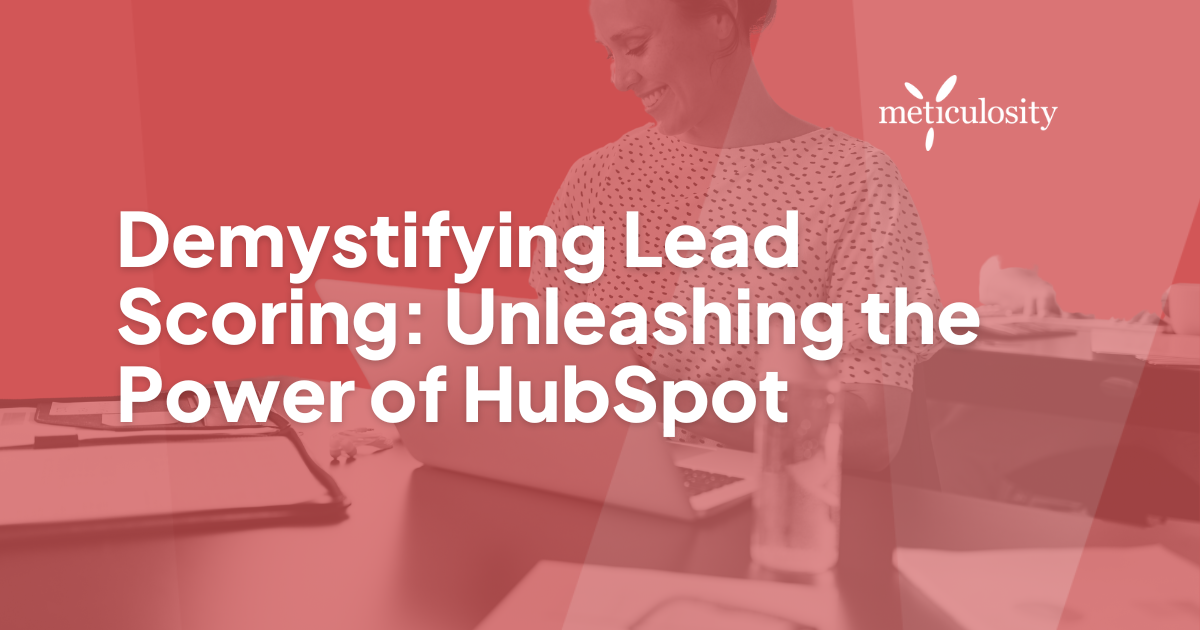Familiar with the stress of sifting through countless unqualified leads, trying to figure out where to direct your energies for maximum returns?
Today's blog is all about deciphering the science behind HubSpot's lead scoring system - a nifty tool that can help transform those daunting stacks of leads into tangible profits.
Key Takeaways
- HubSpot Lead Scoring is a tool that helps businesses identify which leads are ready to buy and worth contacting right away.
- Implementing HubSpot Lead Scoring offers benefits such as streamlined lead qualification, improved efficiency and productivity, and enhanced collaboration between sales and marketing teams.
- To effectively implement HubSpot Lead Scoring, businesses should define their ideal buyer persona, assign point values to lead behaviors and characteristics, set up scoring rules and thresholds, and regularly review and refine their lead scoring model.
- Identifying high-scoring leads allows businesses to focus their efforts on those most likely to convert while tracking conversion rates helps measure the effectiveness of the lead scoring model. Regularly measuring success ensures ongoing optimization of the lead-scoring strategy.
Understanding HubSpot Lead Scoring
HubSpot Lead Scoring is a tool you can use. It helps you see who is ready to buy and who needs more time. You give points for things such as visits to your site, emails opened, or forms filled out.
The more points a lead gets, the hotter they are.
Hot leads act like your best customers. They show interest in what you sell and interact with your content. These hot leads have high scores because of their actions.
HubSpot will track these scores for you so it is easy to see which leads are hot and worth calling right away.
Benefits of Implementing HubSpot Lead Scoring
Implementing HubSpot Lead Scoring offers several benefits, including streamlined lead qualification, improved efficiency and productivity, and enhanced collaboration between sales and marketing teams.
Streamlined Lead Qualification
HubSpot Lead Scoring makes lead qualification easy. You can score a lead based on their actions and traits. This lets you spot hot leads fast. High scores mean high interest.
With this tool, your team wastes less time on poor leads. They focus on real buyers instead. The result is more sales in less time. Isn’t that what we all want?
Remember, a good scoring model is key to success.
Improved Efficiency and Productivity
HubSpot Lead Scoring does magic for your work pace. You no longer waste hours on leads that just won't bite. Now, you instantly spot the hot ones ready to buy. Your day gets a real boost! No more after-work stress or long days.
It's like hiring a helper who never sleeps or takes breaks! Marketing turns into smooth sailing with less strain and more gains. And guess what? When you score big in productivity, you nail it in profits too!
Enhanced Collaboration Between Sales and Marketing
Collaboration between sales and marketing is crucial for the success of any business. With HubSpot Lead Scoring, this collaboration is enhanced even further. By implementing lead scoring, both teams can work together more efficiently and effectively.
Marketing can provide sales with better-qualified leads based on their behaviors and characteristics, while sales can offer valuable insights to help refine the lead scoring model.
This increased collaboration ensures that both teams are aligned in their efforts and working toward the same goal of generating more revenue for the business. Together, sales and marketing can make smarter decisions, prioritize leads more effectively, and ultimately drive greater customer acquisition and retention rates.
Setting Up Your HubSpot Lead Scoring Model
Setting up your HubSpot Lead Scoring Model is essential for effectively qualifying leads and increasing conversion rates. Learn how to define your ideal buyer persona, assign point values to lead behaviors, and set up scoring rules and thresholds to maximize the power of HubSpot.
Defining Your Ideal Buyer Persona
To effectively score leads with HubSpot, it's important to start by defining your ideal buyer persona. This means understanding who your target customers are and what they need. Think about their demographics, interests, challenges, and goals.
By creating a detailed profile of your ideal buyer persona, you can better align your marketing efforts and tailor your lead scoring criteria to attract the right prospects. Consider factors like job title, industry, company size, budget constraints, and buying behavior.
This will help you focus on leads that have a higher likelihood of becoming customers and avoid wasting time on those who don't fit your target audience.
Assigning Point Values to Lead Behaviors and Characteristics
When assigning point values to lead behaviors and characteristics in HubSpot Lead Scoring, it's important to consider the actions and attributes that indicate a high level of engagement and interest from your leads.
Focus on behaviors such as website visits, email opens, form submissions, and content downloads that show genuine intent. Assign higher point values to these actions to reflect their significance in the buying process.
Additionally, consider lead characteristics like job title, industry, company size, and budget that align with your ideal buyer persona. Give higher scores to leads that match these criteria as they are more likely to convert into customers.
Regularly evaluate and adjust your scoring model based on data analysis and feedback from sales team collaboration for optimal results.
Setting Up Lead Scoring Rules and Thresholds
Setting up lead scoring rules and thresholds is an important step in implementing HubSpot Lead Scoring. Here's how you can do it effectively:
- Define your ideal buyer persona: Identify the characteristics and behaviors that make a lead a good fit for your business. Consider factors like job title, industry, company size, and engagement with your content.
- Assign point values to lead behaviors and characteristics: Determine the importance of different actions and attributes when scoring leads. For example, downloading a whitepaper might be worth 5 points, while attending a webinar could be worth 10 points.
- Set up lead scoring rules: Create rules that assign point values based on specific lead behaviors or characteristics. For instance, visiting certain website pages or filling out a form can trigger an increase in lead score.
- Establish thresholds for qualified leads: Decide on a minimum lead score that indicates a qualified lead. This threshold should align with your sales team's criteria for engaging with prospects.
Looking to optimize HubSpot for your business? Learn how to improve here.
Identifying Your Top Performers
Identifying High Scoring Leads allows you to focus your efforts on leads that are most likely to convert, saving time and resources. Tracking Conversion Rates helps you measure the effectiveness of your lead-scoring model and make necessary adjustments.
Measuring Success allows you to see how well your lead scoring is working in terms of driving revenue and achieving marketing goals.
Identifying High-Scoring Leads
To identify high-scoring leads in HubSpot, you need to pay attention to certain things. Look for leads that have accumulated a higher number of points based on their behaviors and characteristics.
These are the leads that have shown a strong interest in your products or services.
Another way to identify high-scoring leads is by tracking conversion rates. See which leads are converting at a higher rate, as this indicates they are more likely to become customers.
Lastly, measure success by analyzing the performance of these high-scoring leads. Look at metrics such as revenue generated, customer retention rate, and overall business growth. This will help you understand the impact of your lead-scoring efforts.
Tracking Conversion Rates
Tracking conversion rates is a crucial step in assessing the success of your lead-scoring efforts. By monitoring how many leads are converting into customers, you can gauge the effectiveness of your lead scoring model and make any necessary adjustments.
This data allows you to identify which leads are most likely to convert and focus your resources accordingly. Regularly analyzing conversion rates helps you measure the impact of your marketing campaigns and determine areas for improvement.
By staying vigilant and proactive in tracking conversion rates, you can continually refine your lead-scoring strategy for optimal results.
Measuring Success
Now that you have set up your HubSpot lead scoring model and started identifying high-scoring leads, it's important to measure your success. By tracking conversion rates and analyzing the performance of your top performers, you can determine how effective your lead-scoring efforts are.
Regularly review and refine your lead scoring model based on these insights. Remember to update and adjust your model as needed to ensure continued success. By consistently measuring and tracking your results, you can optimize your lead-scoring strategy for maximum impact on marketing and sales outcomes.
Best Practices for Effective HubSpot Lead Scoring
Regularly reviewing and refining your lead scoring model is crucial for optimizing its effectiveness and ensuring it accurately reflects buyer readiness. Measure and track success metrics to gauge the impact of your lead-scoring efforts, while also being proactive in updating and adjusting your model as needed to align with evolving marketing strategies.
Regularly Review and Refine Your Lead Scoring Model
To ensure the effectiveness of your lead scoring efforts, it's important to regularly review and refine your lead scoring model. This means taking the time to assess how well your current criteria and point values are capturing the behaviors and characteristics that indicate a qualified lead.
By reviewing your model regularly, you can identify any areas for improvement or adjustments. Look at key metrics like conversion rates and engagement levels to see if some any patterns or trends suggest changes may be needed.
Don't be afraid to make updates as necessary - staying proactive with refining your lead scoring model will help you better prioritize leads and ultimately drive more successful sales outcomes.
Measure and Track Success
To ensure the effectiveness of your HubSpot lead scoring model, it is crucial to measure and track its success. By regularly reviewing and analyzing the results, you can identify your top-performing leads and make informed decisions for your marketing and sales strategies.
Track conversion rates to see how well your high-scoring leads are progressing through the sales process. This will give you insights into which behaviors or characteristics are most indicative of buyer readiness.
With this data, you can update and adjust your lead scoring model as needed to continually improve its accuracy. Remember, measuring success is key to optimizing your lead-scoring efforts.
Update and Adjust Your Model as Needed
Once you have set up your HubSpot lead scoring model, it's important to regularly update and adjust it as needed. This ensures that your lead scoring system remains effective and aligned with your business goals.
As market trends change and buyer behaviors evolve, you may need to tweak the criteria or point values assigned to certain actions or characteristics. By reviewing and refining your model regularly, you can maximize its accuracy and relevance, leading to better lead prioritization and more successful conversions.
Remember to measure and track the success of any changes you make to see how they impact your lead qualification process. Stay proactive in keeping your lead scoring model up-to-date for optimal results!

Common Mistakes to Avoid
Over-scoring or Under-scoring Leads
It's important to avoid over-scoring or under-scoring leads when implementing HubSpot lead scoring. Over-scoring means assigning too many points to certain behaviors or characteristics, which can result in inaccurately identifying high-value leads.
Under-scoring, on the other hand, means not assigning enough points, leading to missed opportunities with potentially valuable leads.
To prevent these mistakes, it's crucial to regularly review and refine your lead scoring model. This involves analyzing the data and feedback collected from your sales team to ensure that the assigned point values accurately reflect a lead's potential value.
Neglecting to Measure and Analyze Results
One crucial mistake to avoid when implementing HubSpot Lead Scoring is neglecting to measure and analyze the results. Without proper tracking and analysis, you won't know if your lead scoring model is effective or if it needs adjustments.
Regularly reviewing the data allows you to identify patterns, understand which leads are converting into customers, and make informed decisions about allocating resources. By measuring success, you can optimize your lead scoring model for better results and drive more qualified leads through the sales process.
So don't overlook the importance of measuring and analyzing your lead scoring efforts!
Not Collaborating with the Sales Team
Collaborating with your sales team is crucial for the success of your lead-scoring strategy. Without collaboration, you may miss out on valuable insights and feedback that can improve your lead qualification process.
By working together, marketing and sales can align their efforts and ensure that leads are properly scored based on their likelihood to convert. This collaboration also helps in refining the lead scoring model over time as both teams learn more about what characteristics and behaviors indicate a high-quality lead.
So, make sure to involve your sales team in the implementation and ongoing management of your HubSpot lead scoring system to maximize its effectiveness.
Incorporating Lead Scoring into Your Sales Process
Integrate HubSpot with your CRM to seamlessly update lead scores as they progress through the sales process, ensuring effective prioritization and personalized nurturing.
Integrating with CRM Data
Integrating with CRM data is a crucial step in the lead-scoring process. By connecting your HubSpot system with your CRM software, you can gather valuable information about your leads and enhance your lead scoring model.
This integration allows you to track and analyze customer interactions, such as email opens, website visits, and form submissions. With access to this data, you can better understand each lead's behavior and engagement level, which helps prioritize them for sales follow-up.
By integrating HubSpot with your CRM data, you can streamline the sales process and improve collaboration between marketing and sales teams.
Updating Lead Scores as They Progress Through the Sales Process
As leads progress through the sales process, updating their lead scores in HubSpot is important. This helps you keep track of their engagement and prioritize them accordingly. By updating lead scores, you can identify which leads are showing more interest and moving closer to becoming customers.
It allows you to focus your efforts on those most likely to convert, saving time and increasing efficiency. Regularly updating lead scores also provides insights into the effectiveness of your marketing strategies by tracking how well leads respond to different actions or campaigns.

Conclusion
In conclusion, understanding and implementing HubSpot Lead Scoring can greatly benefit your business. You can effectively identify top performers and optimize your sales process by streamlining lead qualification and improving efficiency and collaboration between sales and marketing teams.
Remember to regularly review and refine your lead scoring model, measure success, and adjust as needed. Avoid common mistakes like over-scoring or under-scoring leads, neglecting to analyze results, or failing to collaborate with your sales team.
Incorporating lead scoring into your sales process by integrating with CRM data can further enhance the power of HubSpot for nurturing leads and driving conversions.
Click here to learn more about HubSpot marketing.
FAQs
1. What is lead scoring in HubSpot, and why is it essential for my business?
Lead scoring in HubSpot is a system that assigns numerical values (scores) to leads based on their behavior and interactions with your website and content. It helps businesses prioritize and focus their efforts on leads more likely to convert into customers. By assigning scores to information, companies can identify the most engaged and competitive marketing and sales strategies.
2. How does lead scoring work in HubSpot?
Lead scoring in HubSpot is based on implicit and explicit criteria. Implicit criteria include actions like page views, email opens, and form submissions, while clear criteria involve characteristics like job title, industry, and company size. Each interaction or attribute is assigned a point value, and these points accumulate to form a lead's overall score. Leaders with higher scores are considered more engaged and potentially closer to making a purchasing decision.
3. How can I set up lead scoring in HubSpot for my business?
-
Define Your Ideal Customer Profile (ICP): Determine the characteristics and behaviors that indicate a lead's potential to become a customer.
-
Identify Scoring Criteria: Decide which actions and attributes are most relevant to your ICP. For example, assign higher scores to activities like downloading a whitepaper or visiting a pricing page.
-
Assign Point Values: Set point values for each identified criterion. Consider the relative importance of different actions and attributes to your sales process.
-
Automate Scoring Rules: Use HubSpot's automation features to assign scores to leads based on their interactions automatically.
-
Regularly Review and Adjust: Monitor the effectiveness of your lead scoring system and adjust point values or criteria as needed to align with your evolving business goals.
4. How can I use lead scores to improve my marketing and sales efforts?
-
Prioritize Outreach: Focus your sales team's efforts on leads with higher scores, as they are more likely to be interested and engaged.
-
Personalize Marketing Campaigns: Customize content and messaging for leads based on their scores to ensure relevance and effectiveness.
-
Optimize Lead Nurturing: Tailor leads nurturing campaigns to cater to the specific interests and behaviors of leads with different scores.
-
Measure Marketing ROI: Evaluate the effectiveness of your marketing campaigns by tracking how leads with different scores progress through the sales funnel.
-
Align Sales and Marketing Teams: Lead scores provide a standard metric both teams can use to understand and prioritize leads, fostering better collaboration.






